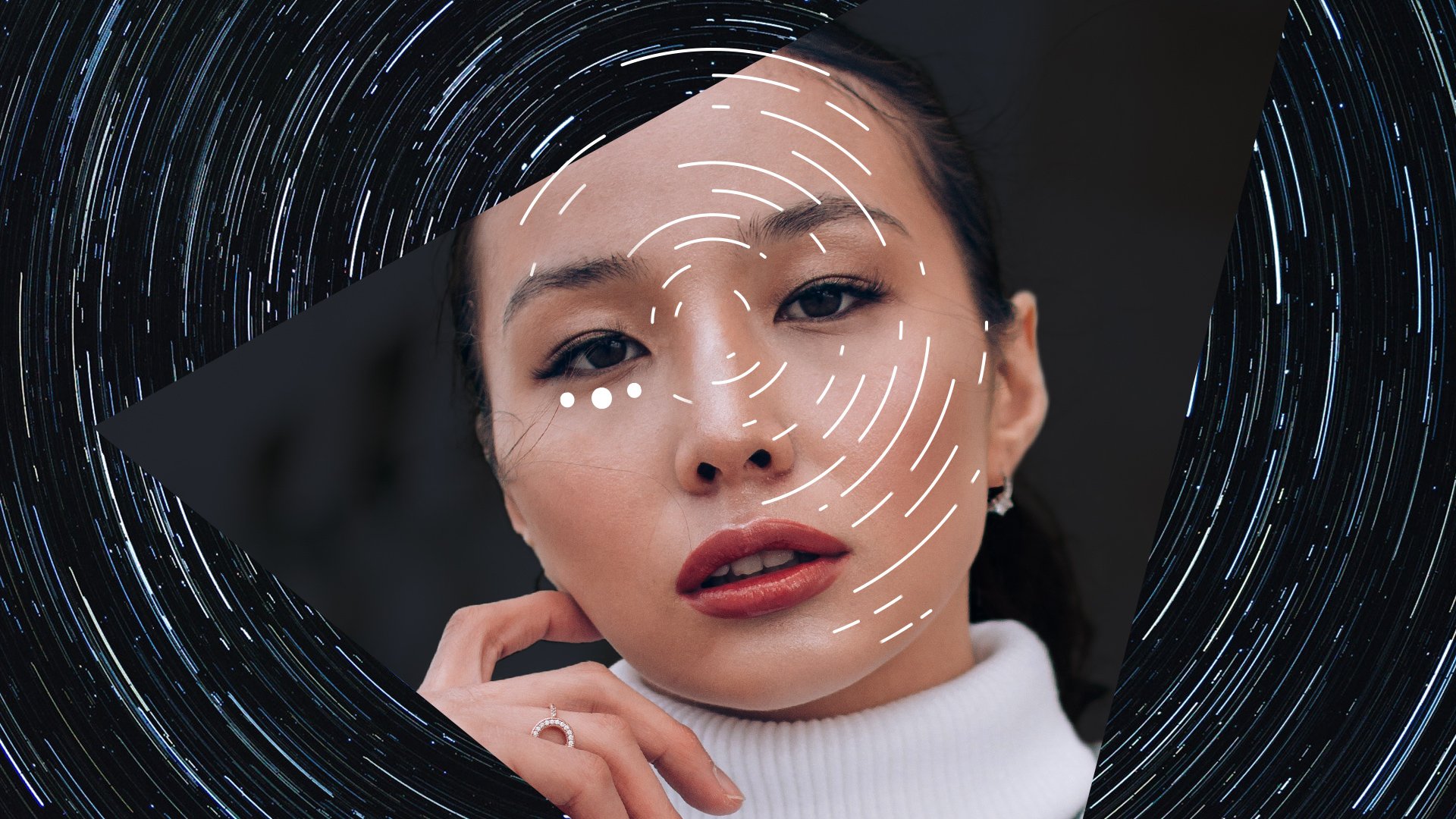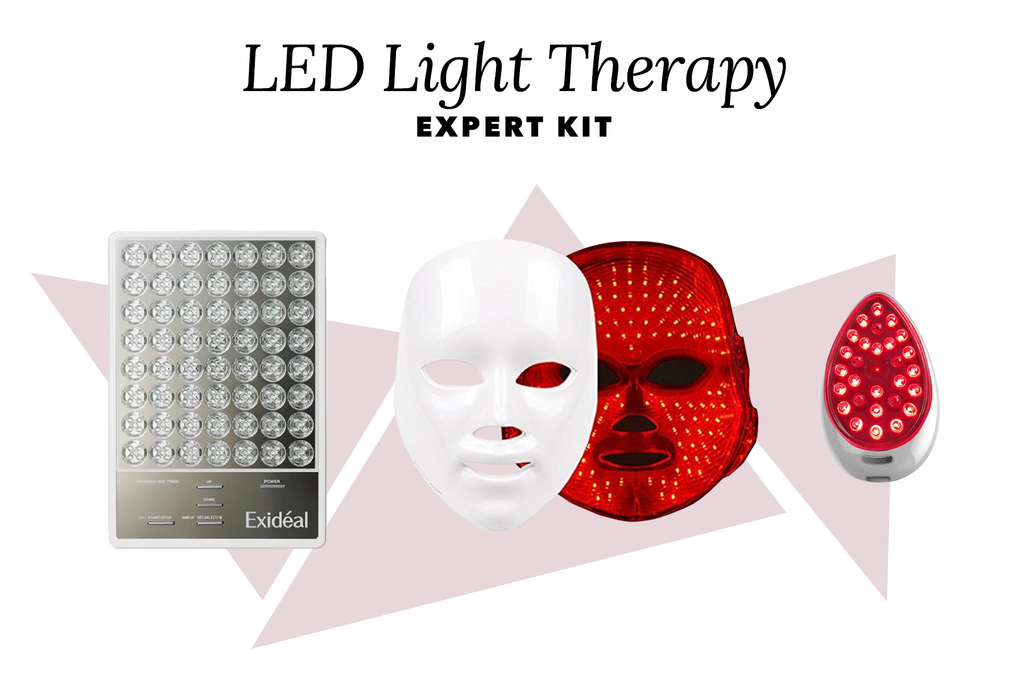Trendy beauty ‘miracles’ don’t always deliver on their promises to erase wrinkles, zap zits or turn back time. Luckily, there are tried-and-tested solutions that answer the call for healthy, youthful skin.
One of the most all-around effective options available is LED light therapy. Proven to erase fine lines, stimulate collagen, treat acne and improve skin tone and clarity, this non-surgical aesthetic treatment is an essential ingredient in every skincare regime.
Furthering its appeal, LED is gentle, non-invasive, painless and works for everyone no matter your age or skin tone. It also works seamlessly when combined with other treatments, such as RF and HIFU, making it one of the most versatile beauty solutions in the world.
Here’s why we’ve chosen LED
- The best complementary beauty technology thanks to its many healing benefits
- Works for all ages, skin types and tones – especially sensitive skin
- Highly effective for skin brightening, sun damage, scar reduction and acne
- Easily incorporated into daily or weekly self-care routine
- No contraindications of any kind
- Gentle, non-invasive and requires no downtime
- Enhances collagen production and smooths wrinkles
- Promotes circulation and scar healing
- Reduces inflammation, redness and acne
- Treats rosacea, eczema and psoriasis
Used by NASA and Celebrities
Well researched by the science community, LED light therapy was first introduced as a NASA technology in the early 1990s. LEDs (short for ‘light-emitting diodes’) were discovered by the space agency as a way to stimulate plant growth and, potentially, grow vegetables in zero gravity.
Subsequently, scientists used LED light therapy on astronauts, to see whether it would heal wounds incurred in space. It did, faster than expected. In the span of just a few years, further research led the medical community to adopt LED to treat post-surgical scars, skin conditions such as psoriasis and eczema, and even some types of skin cancers, combined with targeted drugs.
In the late 2000s, doctors discovered that LED light therapy also boosted collagen production, and the treatment entered the cosmetic world. Today, LED light therapy is the anti-aging remedy of choice for many A-listers – including Kate Hudson, Kristen Bell, Jessica Alba and Chrissy Teigen, to name a few. Dermatologists and aesthetic therapists regularly recommend LED for clinical treatments and, with a growing selection of effective home devices, the technology is more accessible than ever before.
5 Different Wavelengths, 5 Different Beauty Solutions
Here’s how it works: LED devices – which vary from lamps to masks to hand-held tools – dispense diodes that pulse in pre-programmed patterns of red, blue, yellow, green or infrared light. Each color signifies distinct wavelengths of light, which penetrate the epidermis at different depths.
Red light penetrates deep within the skin with wavelength at 630 nanometers, to be precise – to stimulate collagen, enhance cell repair, and calm redness. At 415 nanometers, blue light kills blemish-causing bacteria while easing inflammation and preventing future breakouts (making it ideal for acne-prone skin); at 520 nanometers, green evens out skin tones and reduces pigment spots; and amber, at 580 nanometers, is used for inflammatory conditions and redness. Infrared blends different levels of energy depending on one’s goals, working on everything from smoothing fine lines to improving texture and tone.
Which color is right for you?
| Color | Wavelength | Skin Concern | Benefits |
| Blue | 415 nm | Acne, eczema, psoriasis | Reduces oil production, prevents breakouts, treats eczema and psoriasis |
| Green | 520nm | Uneven skin tone, brown spots | Slows production of melanin, reduces pigmentation, fade freckles, age spots, sun spots brown patches |
| Yellow | 580nm | Redness, inflammation, sun damage, veins, collagen loss, scarring | Reduces skin redness, promotes collagen production, reduces scars. Also effective on spider veins and blood vessels |
| Red | 630nm | Skin repair, hydration, sunken skin, sun damage, rosacea | Increases natural hydration, reduces redness and inflammation, boosts collagen and plumps skin, shrinks appearance of pores and fine lines, regulates oil production, improves circulation, accelerates skin repair, treats rosacea |
| Infrared and Red | 830nm - 1000nm | Wrinkles, volume loss, wounds, cystic acne | Increases absorption, smooths wrinkles, improves elasticity, reduces inflammation, accelerates wound healing, heals cystic acne |
How wavelengths penetrate skin
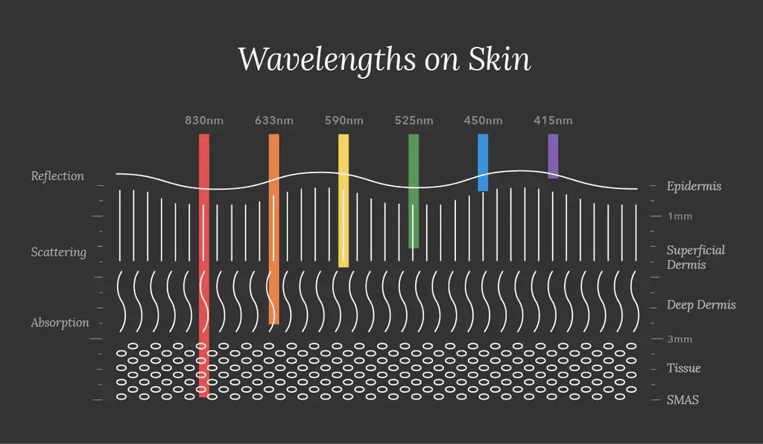
When the light interacts with skin, it encourages cells to produce more of a chemical called adenosine triphosphate, or ATP, which in turns fuels healthy cell grow. The process sets in motion a series of metabolic events, from speeding up circulation and cell reproduction to tissue repair. With higher ATP, fibroblast cells – active stem cells in charge of producing the skin’s connective tissue – are better at producing collagen and elastin. As a result, skin looks and feels smoother, plumper, brighter and younger.
But it’s important to keep in mind that not all LED light devices use all five colored lights. Red, blue and infrared are the most common amongst at-home cosmetic devices. Some device may offer combination of different color lights in one single treatment.
How it works
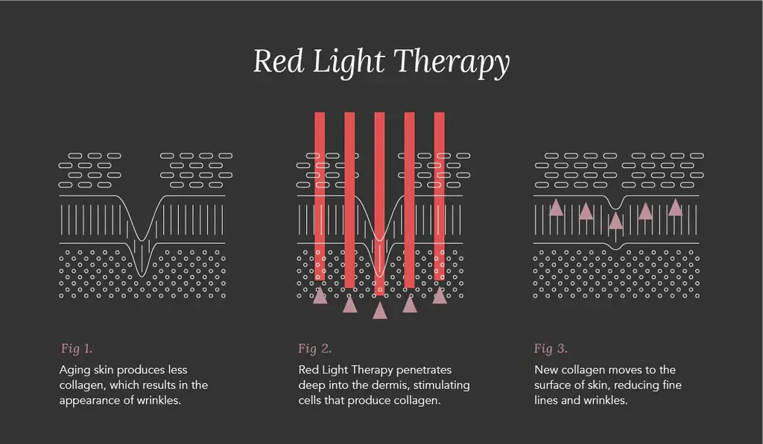
Related: Overall of all Anti-aging Beauty Treatments
Need to know
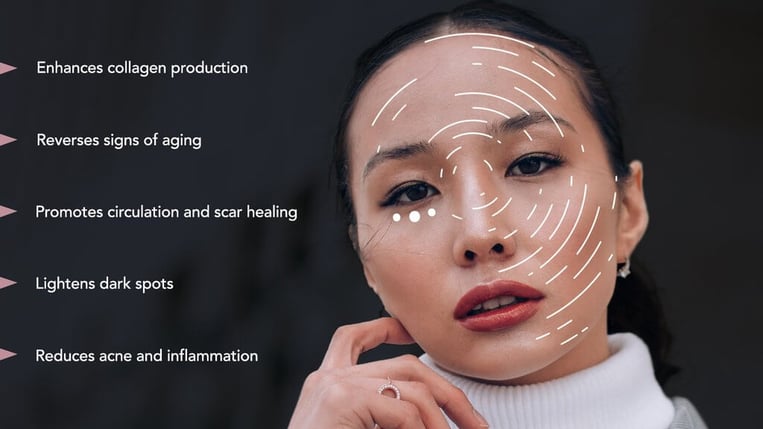
Who is it for? Well, pretty much anyone who wants better-looking skin! LED has no age limitations (acne-prone teenagers can benefit from it too), as it’s the least invasive high-tech beauty treatment out there.
How often should I use LED therapy? Two to five times a week is the norm, though it depends on your device. Usually, you’ll start to see results in three to four months. At that point, you can reduce to less frequent maintenance sessions.
How long is each session? It totally depends on the surface area of your device. The smaller the surface area, the longer the session. To be safe, it’s best to refer to the instructions on your home device.
Does it require any downtime? Nope! LED light therapy is extremely gentle, meaning you could administer LED during your lunch break, then dive back in. The whole process feels soothing and calming on the skin.
Does it hurt? Not at all. You’ll simply feel a slightly warm sensation.
Where do you use it? LED can be applied on the face, to minimize wrinkles and treat acne and blemishes.
Does it work? Yes! Backed by rigorous scientific studies, LED light therapy delivers visible benefits to the skin when used regularly.
How long before I see results? It’s all about the long game here. It will take about a month of regular treatments to see full results.
Will I get tan? No chance. LED therapy does not use UV light and will not change the color of your skin.
Any side effects? LED therapy is one of the only non-invasive beauty treatment without any side effects.
Is it safe to use while pregnant? While there is no known side effects, we recommend to be cautious with treatment choice during pregnancy and breastfeeding period where a woman's body goes through hormonal changes. Consult your GP or a relevant medical specialist if you have any concern.
LED vs other light-based therapies
As a non-invasive treatment, LED light therapy is more gentle and soothing than therapies like chemical peels, laser resurfacing, IPL and microdermabrasion. These types of treatments spur the body to create collagen through heat and damage, which can leave the skin looking red or feeling inflamed. But there’s a tradeoff. Since LED emits very low-energy diodes, the results take months rather than weeks.
LED is most often compared with IPL, since both therapies are used to boost collagen, treat sun damage, diffuse redness and brighten skin. However, IPL (intense-pulsed light) uses powerful, broad-spectrum light to penetrate deep within the skin and cause blood vessels and collagen fibers to constrict. Because it’s very powerful, IPL can cause some discomfort, redness and sometimes mild burning. If you’re deciding between LED and IPL, keep in mind that the latter will provide better and faster results for concerns such as spider veins, brown spots and wrinkles.
Another commonly compared treatment is PDT (photodynamic therapy). During PDT, LED light (either red or blue) helps skin cells absorb a chemical called a photosensitizer to stimulate new cell development and reverse sun damage. Sessions can last anywhere from 30 minutes to three hours at a time and must be done at a salon or medi-spa.
These sessions can be uncomfortable, particularly when deep-penetrating red light is used. Because of the photosensitivity of the chemical used, patients may experience swollenness and redness after treatment, followed by peeling for a few days. If you’ve had a PDT treatment, it’s essential to avoid sun exposure for 48 hours. Compared with PDT, LED therapy is significantly more comfortable and convenient. Not only can it be performed at home using a portable device, but the therapy also provides skin-healing benefits – it stimulates cellular repair, reduces redness and soothes damaged skin. That’s why LED is often recommended as a complementary therapy for deeper non-surgical treatments like RF technology, HIFU and laser.
Try LED therapy at home
With an array of convenient, at-home devices available on the market, you don’t have to visit a salon to try LED therapy. Using the same cutting-edge technology you’d find at a spa or clinic, high-performance at-home LED products vary from hand-held devices to visors, goggles and all-over face masks.
When choosing a LED therapy device, consider your lifestyle and skincare needs. For example, LED masks and table stands are best for the time-poor. Since these devices have larger surface areas, diodes can penetrate skin faster and each session requires less time.
A palm-sized handheld device or a ‘pen’ tool will likely have a smaller surface area and, as a result, will require more time. That said, these portable tools are ideal for travel and targeted areas. They’re especially effective on eczema and psoriasis which, for some women, may occur on delicate areas like the eyes and upper lip.
One of the best at-home options on the market is LED Phototherapy Face Mask Device. Using low-level color light therapy in three wavelengths, the all-over mask stimulates cellular repair and addresses a slew of skin troubles, including acne, fine lines, tone, texture and elasticity.
.png?width=180&height=80&name=imgpsh_fullsize_anim%20(1).png)
